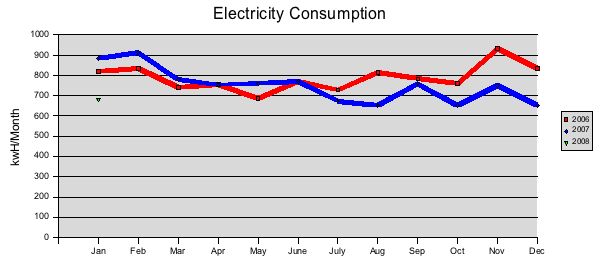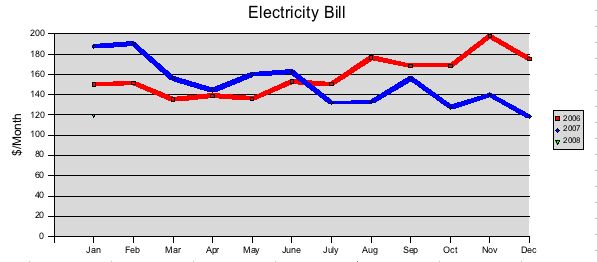Real Data on CFL Replacement
People are making all sorts of claims about energy efficient lighting, and we’re on that bandwagon too. Having systematically inventoried, evaluated, and replaced incandescent lighting with compact fluorescent lamps in June, 2007. In fact, one of the most popular entries ever to appear in this journal was titled “Want to get $3,500?” which talks about the inventory, method, and expected savings of replacing standard lighting with energy efficient lighting. With seven months of data available, I thought it was time to check expectations with reality.
Here are the headlines:
- Total kwH saved: 920
- Total $ saved (electricity bill): $299.18
- Total lightbulb burnout replacement $ avoided: $42.00
- Equivalent tree impact: 48 trees planted
In seven months, we’ve recovered the “real $” investment in replacement lamps just with the savings in the monthly utility bill and lack of bulb replacement from burn outs. It was a great theory in June, it’s even better seeing it in reality in February. The chart below shows the actual electricity consumption change over time. We’ve got data from January of 2006 (so a full year of incandescent bulbs) and the first 6 months of 2007. The bulbs were replaced in the third week of June, 2007.

Now kwH reduction is interesting, but absolute cost reduction is king. Sure, we all want to to things that help the planet, but when you can combine that with a real measurable economic impact, that’s even better! The actual electricity charges are listed below for the same time period. One might notice that September was a funky month, it’s due to a large-scale data storage test that was conducted in this location and it almost accounted for the entire months savings. It’s easy to affect these numbers with activities like that.

One important thing to note about the cost savings on the monthly electrical bill, PG&E penalizes consumers rather stiffly for what it considers to be excessive use of power. Meaning the rates graduate from the base consumption of around $0.11/kwH to $0.32/kwH as the top tier rate. The lighting change is displacing kwH charged at the higher rate in our case, so if you choose to do this, make sure you understand how much you’re paying per kwH because it will affect your results.
Three other items of note: before the CFL bulbs, we were replacing about 1.5 incandescent lightbulbs per month (~$4 cost for the bulbs that would blow) – we’ve had zero replacements thus far in the CFL era. We haven’t had a break or replace situation, so cleanup and recycling hasn’t become an issue yet, this is still harder than it needs to be as we’ve had to dig to find places that will accept these bulbs post-use. It’s important to handle them properly as there is a small amount of mercury in the bulbs (with over 80 installed, it’s still far less than the amount of mercury in old of the old, small thermometers to put the risk in perspective.)
Finally, we have had one adjustment with respect to lighting, the 20 second or so “warm up” period. When the bulb is switched on, it goes to about 70% of illumination. Within 20 seconds, it’s up to 100%. At first, this is a little disconcerting, but it’s not noticed any more. The quality of the light is equivalent or better than the incandescent bulbs – it’s warm and full spectrum (choose your CFL’s carefully, we prefer the Philips brand for light quality and warmth.)
Convinced to make the switch yet? If you do, please leave a comment to let us know how it went. More data is better.









[…] also save money by replacing your old incandescent bulbs with compact fluorescent. We’ve got real data on electricity consumption before and after switching out the 83 of 95 bulbs in one home. Think it’s pennies? You’d be surprised, we’re on track for a $4,100 savings – […]